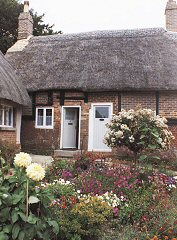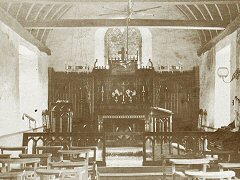Wimborne's
leper hospital
Nicholas Lock tells the story of St Margaret's
( an
article from Dorset Life)
|

A hundred years
ago, the almshouses were surounded by countryside.
|
| Wimborne is not the
sort of place that one immediately associates with leprosy, yet in the 12th
century the town had its own leper hospital, St Margaret’s, outside the
town boundary beside the high road to Blandford. Irene Allen of LEPRA (the
charity with the message ‘Leprosy still exists – with your help we can cure
it’) says that leprosy was at its peak in Britain in the late 15th century
but had virtually died out a hundred years later, with the last case lingering
in the Outer Hebrides in 1798. Extraordinarily, the disease was originally
most prevalent in the northern hemisphere. Now it blights millions of lives
in India, Africaand South America, in spite of the fact that treatment costs
in the region of only £25 per person. Just as today’s charities rely on
the generosity of benefactors, so St Margaret’s Hospital relied on the church
and the aristocracy for its funds. One effective way to raise money then
was through the issue of ‘Indulgences’, offering remission of varying amounts
of time in Purgatory in exchange for the donation of alms – a system not
covered by guarantee! Between 1243 and 1254 Pope Innocent IV issued one
such indulgence offering remission of 51 years 260 days, a seemingly odd
term presumably calculated by some papal actuary having access to a scale
of severity of sin and the magnitude of the donation. The Pope’s lead was
followed by Peter, Bishop of Exeter, who issued 30 days remission to benefactors
of St Margaret’s; it would appear that bishops might not have been endowed
with the same capacity for forgiveness as their boss. The benefactions came
not only in cash but in kind, so at the end of the 13th century Henry de
Lacy, Earl of Lincoln, gave an acre of his Kingston Lacy Estate to St Margaret’s
and his manorial steward followed suit by granting the hospital some land
at ‘Worth’, adjacent to Walford Mill. |

The popularity
of gardening among the residents ensures that there is always a colourful
display in the summer.
|
| Indulgences clearly
became a popular fund-raising tool and were mass-produced by the papal scribes,
so much so that when a John Thoker signed on the dotted line for his remission
of sins in 1413, little did he know that the other signatory, Pope Alexander
V, had died in 1410! This method of fund-raising continued well into the
16th century, and much of the documentary evidence relating to benefactors
of St Margaret’s is now preserved in the County Record Office at Dorchester.
In 1685, St Margaret’s received its largest-ever gift. William Stone, Principal
of New Inn Hall, Oxford, and a minister at Wimborne Minster since 1661,
left all his property in Wimborne for the benefit of ‘the hospital of St
Margaret’s’; this included the properties in West Street which remain to
this day the principal source of revenue for the charity. With the disappearance
of leprosy from England, the role of St Margaret’s changed to that of an
almshouse. It is clear that by the end of the 17th century the five cottages
at St Margaret’s were occupied by poor local people and there is some suggestion,
although no firm evidence, that the cottage adjoining the chapel was occupied
by the resident priest. There were strict rules by which the residents had
to live, including that they had to attend at the chapel each day at 6 am
and 6 pm, praying ‘devoutly upon their knees one hour’, or pay a fine of
fourpence; and if any resident were ‘unquiet or disturbers of the company
and will not amend by once or twice warning, it shall be lawful for the
said governours to displace and put out of the house such unquiet person
or persons’. Nor were residents allowed to marry! From the middle of the
17th century, St Margaret’s was administered by the Steward of the Manor
of Kingston Lacy. This arrangement continued right up until the death of
Ralph Bankes in 1981, when he gave his entire estate to the National Trust.
However, by then St Margaret’s had been formally registered as an independent
charity, so it was not included in his gift. Little seems to have changed
at the almshouses before the late 19th century, when three new pairs of
cottages were built, presumably to house retired estate employees or their
widows. At around the same time, to quote from the Wimborne Parish Magazine
of May 1901, ‘The old and interesting Chapel belonging to the almshouses
remained in a sad and neglected condition for years, till the late Rev.
R W Fairbank once curate of Wimborne Minster took the matter in hand, and
owing to his zeal and energy was well restored, and on 30th April 1885,
was solemnly re-opened for Divine Service, which has since been regularly
held therein.’ This restoration work was to continue and included provision
of new altar rails ‘made from those taken from Witchampton Church, some
new chairs and a comely carpet’. An oak reredos and side wings carved at
a cost of £20 15s 6d by a Mr A J Kerridge of The Square, Wimborne, was added
in 1903. Sadly, this was subsequently allowed to become infested with furniture
beetle and rot, leading to its removal and destruction together with the
remnants of ancient wall paintings in about 1975, when the chapel was again
the subject of restoration. Now the chapel is a warm and peaceful place
of worship and the weekly services are to this day well attended by local
residents. The work on the chapel in 1975 absorbed virtually all the charity’s
funds and for the last years of Ralph Bankes’s life the properties gradually
deteriorated. In 1981, having been cut off from the 300 years of association
with the Kingston Lacy Estate, with virtually no money and the cottages
in a sorry state, St Margaret’s and Stone’s Charity faced a crisis. In view
of the historic and social value of the almshouses they had to be saved.
With guidance from the Charity Commission a new Trust was created, with
some trustees elected from the parishes served by the charity and others,
including the late Mr Bankes’s steward, selected for their particular knowledge,
expertise and availability. Once again, funds had to be generated.
|
|
|
| The first break-through
was from East Dorset DC, who were able to provide 90% grants towards re-roofing
William Stone’s buildings in West Street . This enabled the charity to increase
its rental income from these endowment properties and to begin the process
of repairing and modernising the almshouses. News of the financial plight
of the charity and its new isolation soon filtered out into the community
and donations (even without the incentive of Indulgences) began to flow.
The British Legion, Help the Aged, the John McCarthy Foundation, the Rotary
Club, the Haycock family, Kingston Lacy Skittles Club and many other individuals
are organisations gave generously, so that at a steadily increasing pace
all the cottages were brought up to reasonably modern standards. The work
involved was enormous. Most of the cottages had death watch beetle, none
had any heating except for an open fire, virtually every roof leaked and
structural timbers had rotted; in one case the weight of new thatch caused
the front wall to bulge to such an extent that it had to be rebuilt, in
cob – and the skills to do that are not always available at the critical
moment. Two adjoining cottages were so small that even when they were amalgamated
they were still really only suitable for single occupancy. Few had bathrooms
and kitchen provision was, at best, primitive. There are now fourteen cottages
providing homes, currently, for sixteen retired people, mostly from farming
or rural backgrounds. Each resident can have a patch to cultivate within
the communal gardens. It is a happy and safe environment, in the countryside
yet close to the town. Now the trustees are looking to the future. Already,
a visitors’ car park has been carefully constructed within the site in such
a way that it will not impinge upon the historic surroundings. During this
work a new mystery was unearthed: a small brass plaque inscribed ‘Lt W.
Turner; 13 Light Dragoons’. Research has revealed that this man fought at
Waterloo, where William John Bankes of Kingston Lacy, a friend of Lord Byron,
was aide-de-camp to the Duke of Wellington (hence the wonderful pictures
at Kingston Lacy and Stratfield Saye House, some of which were captured
off the backs of Napoleon’s mules after he had looted them from the Spanish
during the Peninsular War). Turner wrote a long letter dated 3 July 1815
giving graphic details of the Battle of Waterloo. Did he then return to
England with Bankes, to be housed at St Margaret’s, or was he merely passing
through when he lost his baggage plaque which was to lie undisturbed until
revealed by the 21st-century metal-detector? |
|
|
| St Margaret’s
had been a part of so much of Wimborne’s history. Now the future of
the charity is assured through the generosity of local people and careful
management of its resources and revenue. Plans are already approved to build
four more cottages. The Trustees can sadly no longer offer Indulgences to
raise the £60,000 necessary for each of these new homes, but perhaps
there is someone who would like to provide a perpetual memorial for the
benefit of truly local people through a genuinely local charity.
|
| |
| |



